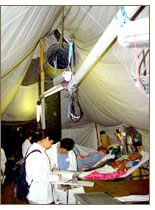|
BACKGROUND OF THE MEETING
 Recent
major disasters in the Americas—including Hurricane Mitch, the landslide
in Venezuela, the earthquakes in El Salvador, Hurricane Isidore, the Peruvian
earthquake and others—have yielded valuable lessons regarding damage
to health facilities and solutions to lessen the impact on critical infrastructure.
This experience, coupled with the conclusions of the regional meeting
on hospital disaster mitigation held in 1996, points to the need to examine
more closely three main topic areas: disaster mitigation, hospital evacuation
and the use of foreign field hospitals. Recent
major disasters in the Americas—including Hurricane Mitch, the landslide
in Venezuela, the earthquakes in El Salvador, Hurricane Isidore, the Peruvian
earthquake and others—have yielded valuable lessons regarding damage
to health facilities and solutions to lessen the impact on critical infrastructure.
This experience, coupled with the conclusions of the regional meeting
on hospital disaster mitigation held in 1996, points to the need to examine
more closely three main topic areas: disaster mitigation, hospital evacuation
and the use of foreign field hospitals.
Approximately 50% of the 15,000 hospitals in Latin
America and the Caribbean are located in high-risk areas. In the last
20 years, more than 100 hospitals and at least 1,000 health care centers
in this region were damaged as a consequence of natural disasters. The
direct cost of these disasters has been enormous, not only were health
services lost (including the interruption of urgently needed health services),
but in some cases the collapse of hospitals caused the death of occupants.
 In
this context, existing regulations concerning the design and construction
of health facilities must be revised and enforced, reorienting them toward
disaster mitigation, with the ultimate goal of protecting
the lives of patients, staff and other occupants and ensuring that these
facilities can continue to function during and after a disaster strikes.
The knowledge on how to build safe hospitals exists and is accessible. In
this context, existing regulations concerning the design and construction
of health facilities must be revised and enforced, reorienting them toward
disaster mitigation, with the ultimate goal of protecting
the lives of patients, staff and other occupants and ensuring that these
facilities can continue to function during and after a disaster strikes.
The knowledge on how to build safe hospitals exists and is accessible.
 At
some point during an emergency or disaster, it may be necessary to evacuate
hospitals. But unnecessary evacuation can lead to serious problems, including
the reintegration of a health facility into the health services network,
which could take several months. The topic of when to evacuate a hospital
will be discussed. At
some point during an emergency or disaster, it may be necessary to evacuate
hospitals. But unnecessary evacuation can lead to serious problems, including
the reintegration of a health facility into the health services network,
which could take several months. The topic of when to evacuate a hospital
will be discussed.
 When
hospitals are evacuated, one way to provide immediate medical care to
victims of natural disasters seems to be the mobile field hospitals
that many Western countries maintain for their defense forces. Some political
authorities in disaster-affected countries have accepted the donation
of self-contained field hospitals as a temporary substitute for health
facilities damaged by disasters. However, often these foreign hospitals
have not met the expectations, generating frustration and disappointment
for all parties concerned: recipients and donor countries, the medical
staff and the patients. On several occasions, field hospitals contributed
to deterioration of health conditions among the affected population and
delayed a return to pre-disaster levels. When
hospitals are evacuated, one way to provide immediate medical care to
victims of natural disasters seems to be the mobile field hospitals
that many Western countries maintain for their defense forces. Some political
authorities in disaster-affected countries have accepted the donation
of self-contained field hospitals as a temporary substitute for health
facilities damaged by disasters. However, often these foreign hospitals
have not met the expectations, generating frustration and disappointment
for all parties concerned: recipients and donor countries, the medical
staff and the patients. On several occasions, field hospitals contributed
to deterioration of health conditions among the affected population and
delayed a return to pre-disaster levels.
Where and when the meeting took place
The meeting was held in San Salvador, El Salvador
from 8 -10 July 2003.
Agenda
| Tuesday,
8 July |
- Opening of the meeting
- Introduction to the topics
- General aspects and current concepts
on hospitals and disasters
- Discussion in working groups (specific
agendas)
|
| Working group A:
Hospital Mitigation |
Working group B:
Hospital Evacuation |
Working group C:
Field Hospitals |
| Wednesday,
9 July |
- Continuation of discussion of working groups (specific agendas)
|
| Working group A:
Hospital Mitigation |
Working group B:
Hospital Evacuation |
Working group C:
Field Hospitals |
| |
| Thursday,
10 July |
- Continuation of discussion in working groups (specific agendas)
|
| Working group A:
Hospital Mitigation |
Working group B:
Hospital Evacuation |
Working group C:
Field Hospitals |
- Preparation of conclusions and presentation of work groups
- General discussion on recommendations and conclusions
|
The meeting was sponsored by

PAHO/WHO also acknowledges the financial support
of the Canadian International Development Agency (CIDA/IHA); the Department
for International Development of the U.K. (DFID/CHAD); and the Office
of U.S Foreign Disaster Assistance (OFDA/USAID).
 UP
UP
|

